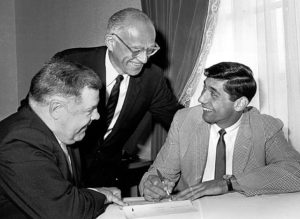
Texas Southern’s Homer Jones was a huge star for the Giants.
Sixteen players from historically black colleges entered pro football in the 1960s and are now in the Pro Football Hall of Fame. Ten of them joined the AFL:
Willie Brown,
Charlie Joiner,
Ken Houston,
Larry Little,
Buck Buchanan,
Art Shell,
Willie Lanier,
Winston Hill,
Elvin Bethea, and
Emmitt Thomas. By comparison, only six future Hall of Famers entered the NFL from HBCUs despite the senior league having more teams:
Deacon Jones,
Lem Barney,
Rayfield Wright,
Leroy Kelly,
Bob Hayes, and
Claude Humphrey. And the lasting image of the AFL-NFL wars was Super Bowl IV, a game that saw the 12-point underdog Chiefs, with
8 starters from historically black colleges, upset a Vikings team with zero such players. Those are two of the big reasons, along with
actual words from those in pro football at the time, that the AFL was considered ahead of the curve when it came to bringing in players from these tiny schools.
On the other hand, as we’ll soon see, the narrative doesn’t quite match up with the facts. Three of the ten AFL players — Thomas, Brown, and Hill — were not selected in the AFL Draft; Hill was chosen by the Colts in the NFL Draft, while the other two went undrafted in both leagues. More importantly, six of those 10 AFL Hall of Famers entered the AFL in 1967 or later, which came after the creation of a common draft. These players made most of their marks in the ’70s, and are remembered as NFL stars, now AFL ones. By the time they entered pro football, the AFL had already won: a merger had been agreed upon by the teams, and the credibility of the league had been established. Sure, it was still the inferior league, and it wasn’t until the Jets and Chiefs both won Super Bowls that the league was truly viewed as comparable to the NFL, but the 1967 AFL was very different than the 1961 AFL. When we talk about the AFL as an upstart league that challenged the NFL and won, we are mostly talking about the AFL prior to the 1967 season.
And if we look at the most dominant players who entered pro football from HBCUs between 1960 and 1966, you get a different story. Sure, Buchanan was a big star, but arguably five of the six biggest stars from HBCUs in the ’60s were actually in the NFL: Deacon Jones, Roger Brown, Rosey Taylor, Leroy Kelly, and Bob Hayes.
So let’s take a deeper dive and analyze how the two leagues really approached players from HBCUs prior to 1967. From 1960 to 1966, the two leagues battled over talent, and the AFL’s surprising ability to keep pace is what led to the AFL-NFL merger, announced in June of 1966. Because I am focusing on the talent battle, I am really focused on the two drafts, but will note key undrafted players (and there were several). [continue reading…]



